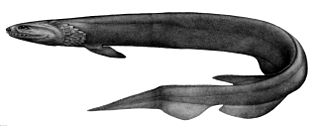Related Research Articles

Sharks are a group of elasmobranch fish characterized by a cartilaginous skeleton, five to seven gill slits on the sides of the head, and pectoral fins that are not fused to the head. Modern sharks are classified within the clade Selachimorpha and are the sister group to the Batoidea. Some sources extend the term "shark" as an informal category including extinct members of Chondrichthyes with a shark-like morphology, such as hybodonts. Shark-like chondrichthyans such as Cladoselache and Doliodus first appeared in the Devonian Period, though some fossilized chondrichthyan-like scales are as old as the Late Ordovician. The oldest confirmed modern sharks (selachimorphs) are known from the Early Jurassic, about 200 million years ago, though records of true sharks may extend back as far as the Permian.

The great white shark, also known as the white shark, white pointer, or simply great white, is a species of large mackerel shark which can be found in the coastal surface waters of all the major oceans. It is the only known surviving species of its genus Carcharodon. The great white shark is notable for its size, with the largest preserved female specimen measuring 5.83 m (19.1 ft) in length and around 2,000 kg (4,410 lb) in weight at maturity. However, most are smaller; males measure 3.4 to 4.0 m, and females measure 4.6 to 4.9 m on average. According to a 2014 study, the lifespan of great white sharks is estimated to be as long as 70 years or more, well above previous estimates, making it one of the longest lived cartilaginous fishes currently known. According to the same study, male great white sharks take 26 years to reach sexual maturity, while the females take 33 years to be ready to produce offspring. Great white sharks can swim at speeds of 25 km/h (16 mph) for short bursts and to depths of 1,200 m (3,900 ft).

The tiger shark is a species of ground shark, and the only extant member of the genus Galeocerdo and family Galeocerdonidae. It is a large macropredator, with females capable of attaining a length of over 5 m. Populations are found in many tropical and temperate waters, especially around central Pacific islands. Its name derives from the dark stripes down its body, which resemble a tiger's pattern, but fade as the shark matures.

The frilled shark, also known as the lizard shark, is one of the two extant species of shark in the family Chlamydoselachidae. The frilled shark is considered a living fossil, because of its primitive, anguilliform (eel-like) physical traits, such as a dark-brown color, amphistyly, and a 2.0 m (6.6 ft)–long body, which has dorsal, pelvic, and anal fins located towards the tail. The common name, frilled shark, derives from the fringed appearance of the six pairs of gill slits at the shark's throat.

A shark attack is an attack on a human by a shark. Every year, around 80 unprovoked attacks are reported worldwide. Despite their rarity, many people fear shark attacks after occasional serial attacks, such as the Jersey Shore shark attacks of 1916, and horror fiction and films such as the Jaws series. Out of more than 500 shark species, only three of them are responsible for a double-digit number of fatal, unprovoked attacks on humans: the great white, tiger, and bull. The oceanic whitetip has probably killed many more castaways, but these are not recorded in the statistics.

Jaws: The Revenge is a 1987 American horror film produced and directed by Joseph Sargent. The fourth and final film in the Jaws franchise, it stars Lorraine Gary, who came out of retirement to reprise her role from the first two films, along with new cast members Lance Guest, Mario Van Peebles, Karen Young and Michael Caine.

The broadnose sevengill shark is the only extant member of the genus Notorynchus, in the family Hexanchidae. It is recognizable because of its seven gill slits, while most shark species have five gill slits, with the exception of the members of the order Hexanchiformes and the sixgill sawshark. This shark has a large, thick body, with a broad head and blunt snout. The top jaw has jagged, cusped teeth and the bottom jaw has comb-shaped teeth. Its single dorsal fin is set far back along the spine towards the caudal fin, and is behind the pelvic fins. In this shark the upper caudal fin is much longer than the lower, and is slightly notched near the tip. Like many sharks, this sevengill is counter-shaded. Its dorsal surface is silver-gray to brown in order to blend with the dark water and substrate when viewed from above. In counter to this, its ventral surface is very pale, blending with the sunlit water when viewed from below. The body and fins are covered in a scattering of small black & white spots. In juveniles, their fins often have white margins.

The school shark is a houndshark of the family Triakidae, and the only member of the genus Galeorhinus. Common names also include tope, tope shark, snapper shark, and soupfin shark. It is found worldwide in temperate seas at depths down to about 800 m (2,600 ft). It can grow to nearly 2 m long. It feeds both in midwater and near the seabed, and its reproduction is ovoviviparous. This shark is caught in fisheries for its flesh, its fins, and its liver, which has a very high vitamin A content. The IUCN has classified this species as critically endangered in its Red List of Threatened Species.
The cast of the television series MythBusters perform experiments to verify or debunk urban legends, old wives' tales, and the like. This is a list of the various myths tested on the show, as well as the results of the experiments.

Seal Island is a small land mass located 5.7 kilometres off the northern beaches of False Bay, near Cape Town in South Africa. The island is so named because of the great number of Cape fur seals that occupy it. It is 5 acres in area and home to 64,000 cape fur seals. It is also home to seabirds, and it is likely that non-marine species fly there to breed as well. The island is an outcrop of Cape granite and rises no more than about 4 to 6 metres above the high tide mark. The island is long and narrow – 800 by 50 metres. There is no vegetation, soil of any significance, or beach.
Shark Week is an annual, week long TV programming block at the Discovery Channel, which features shark-based programming. Shark Week originally premiered on July 17, 1988. Featured annually, in July or early August, it was originally devoted to conservation efforts and correcting misconceptions about sharks. Over time, it grew in popularity and became a hit on the Discovery Channel. Since 2010, it has been the longest-running cable television programming event in history. Broadcast in over 72 countries, Shark Week is promoted heavily via social networks like Facebook and Twitter. Episodes are also available for purchase on services like Google Play Movies & TV/YouTube, Amazon Video, and iTunes. Some episodes are free on subscription-based Hulu and Discovery+.
Discovery Turbo is a pay television channel devoted to programming about transport. It is similar to Discovery Velocity and Motor Trend. It was also briefly available as an on-demand service in the US in the late 2000s.
Discovery Channel is an Indian pay television channel owned by Warner Bros. Discovery for the Indian subcontinent. Launched on 15 August 1995. It is the Indian version of Discovery Channel. It is available in eight languages including Hindi, English, Telugu, Malayalam, Kannada, Bengali and Marathi while the Tamil language has a separate dedicated channel DTamil. The channel can be viewed on digital cable and satellite television in India. The channel also available on its OTT services Discovery Plus.
Blood in the Water is a television film that aired on the Discovery Channel in 2009. It was directed by Richard Bedser. It is based on a true-life series of shark attacks that became the inspiration for Peter Benchley's novel Jaws. It was the season premiere of Shark Week on August 2 for the 2009 season.

HGTV is an American pay television channel owned by Warner Bros. Discovery. The network primarily broadcasts reality programming related to home improvement and real estate. As of February 2015, approximately 95,628,000 American households receive HGTV. The network was bought by Warner Bros. Discovery, then known as Discovery, Inc., in 2018, and it has come to be ranked at No. 4 in audience size among cable networks.
South African born Chris Fallows is an expert on great white sharks and their hunting habits. He has amassed the largest database of predatory events involving great white sharks in False Bay and was the first member of the scientific community to observe the breaching behaviour.
Representations of the shark are common in popular culture in the Western world, with a range of media generally portraying them of eating machines and threats. In some media, however, comedy is drawn from portrayals of sharks running counter to their popular image, with shark characters being portrayed as unexpectedly friendly or otherwise comical. The lists below give an approximate sample of the many forms of representation of the shark in popular culture.

Sharknado is a series of six American made-for-television science fiction action comedy horror disaster films released by Syfy between 2013 and 2018. It has since been expanded into video games and comics, including a spin-off film, Sharknado: Heart of Sharkness, that was released in 2015. The first two films received mixed to positive reviews from critics, while the others received negative reviews.
Port and Starboard are a pair of adult male orcas notable for preying on great white sharks off the coast of South Africa. The duo are identified as having rare and distinct collapsed dorsal fins and they are named for the nautical terms, as Port's fin collapses left and Starboard's collapses right. Port and Starboard are part of a distinctive "flat-toothed" ecotype present around South Africa.
References
- ↑ "Shark Week: Inside two must-see 'Air Jaws: Fin of Fury' moments | EW.com". Entertainment Weekly .
- ↑ "'Air Jaws' proves you can never trust a shark at dinner time". Zap2it . Archived from the original on 2016-06-10. Retrieved 2016-06-12.
- ↑ "Shark Week: Discovery Channel announces full programming lineup | EW.com". Entertainment Weekly .